Related Research Articles

The Vickers Type 131 Valiant was a British general-purpose biplane produced by Vickers in 1927, with the intention of replacing the Royal Air Force's Airco DH.9As, but was unsuccessful, with only a single example built, which was sold to Chile.

The Vickers Virginia was a biplane heavy bomber of the British Royal Air Force, developed from the Vickers Vimy.

The Westland Wapiti was a British two-seat general-purpose military single-engined biplane of the 1920s. It was designed and built by Westland Aircraft Works to replace the Airco DH.9A in Royal Air Force service.

The Short Springbok was a two-seat, all-metal reconnaissance biplane produced for the British Air Ministry in the 1920s. All together six aircraft of the Springbok design were built but none entered service with the armed forces.

The Airco DH.11 Oxford was a British twin-engined biplane bomber which was designed to replace the earlier Airco DH.10 Amiens. It was designed to use the unsuccessful ABC Dragonfly engine and was abandoned after the first prototype was built.

The Bristol Boarhound was a British army cooperation and liaison aircraft of the 1920s. It was a two-seat biplane with wings of equal span, of steel frame construction with fabric covering.
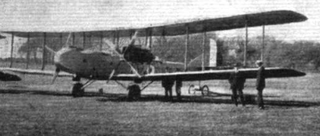
The Avro 529 was a twin-engined biplane long-range bomber of the First World War. Two prototypes were built but no production ensued.

The Blackburn B.T.1 Beagle was a British single-engine, two-seat biplane bomber/torpedo aircraft from 1928. Designed to Air Ministry specifications which led to no contracts for any manufacturer, only one Beagle was built.

The Gloster Goral was a single-engined two-seat biplane built to an Air Ministry contract for a general-purpose military aircraft in the late 1920s. It did not win the contest and only one was built.

The Gloster Goring was a single-engined two-seat biplane designed to meet 1926 Air Ministry specifications for a day/torpedo bomber. It was not put into production and the one aircraft built served later as an engine testbed.

The Gloster TC.33 was a large four-engined biplane designed for troop carrying and medical evacuation in the early 1930s. Only one was built.
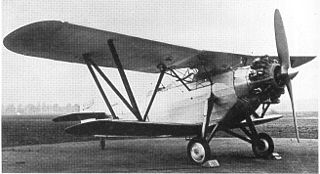
The Bristol Type 118 was a general-purpose military aircraft, a two-seat biplane built by the Bristol Aeroplane Company in the early 1930s, powered by a Bristol Mercury radial engine and aimed at overseas markets. The Type 120 was a Bristol Pegasus-engined variant entered into an Air Ministry competition and later used for armament tests. Two aircraft were built.

The de Havilland DH.56 Hyena was a prototype British army cooperation aircraft of the 1920s. A single-engined biplane, the Hyena was designed against an RAF requirement, but was unsuccessful with only two being built, the Armstrong Whitworth Atlas being preferred.

The de Havilland DH.27 Derby was a large single-engined biplane designed to a heavy day bomber Air Ministry specification. It did not reach production.
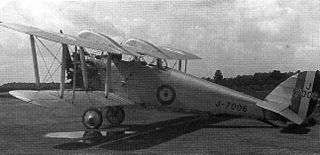
The de Havilland DH.42 Dormouse and its two variants the de Havilland DH.42A Dingo I and II were two-seat single-engined biplanes designed for fighter-reconnaissance and army cooperation roles. They did not achieve production.
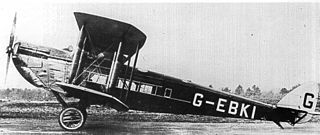
The de Havilland DH.54 Highclere was a single-engined 15-passenger biplane airliner designed to replace the DH.34. Its development ended when Imperial Airways decided to use only multi-engined types.
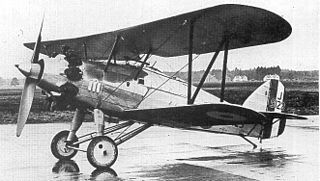
The Hawker F.20/27 was a British fighter design built to an Air Ministry specification for an interceptor in the late 1920s. It was a single-seat biplane powered by a radial engine; the very similar but V-12-engined Hawker Fury development proved superior and only one F.20/27 was built.

The Handley Page H.P.43 was a three-engined biplane bomber-transport built to an Air Ministry specification. It did not fly well and the biplane configuration was out-dated at completion; the only one constructed was later turned into a monoplane and led to the Handley Page H.P.54 Harrow.
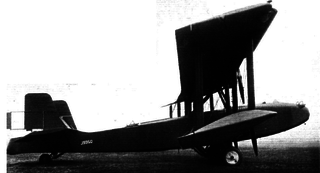
The sole Boulton & Paul P.32 was a British three-engined biplane built to an Air Ministry specification for a long range night bomber. A lack of engine availability slowed construction and by the time it went for tests the thinking on bomber types had moved on.
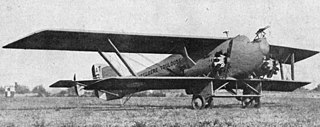
The Latécoère 6 was a French four-engined biplane bomber of the early 1920s. It was of advanced all-metal construction and probably the first aircraft to use geodetic construction. Only one was built.
References
- 1 2 3 4 5 6 Jackson 1978 , pp. 282–3
- ↑ Jackson 1978 , pp. 274
- 1 2 Mason 1994, p. 226
- Jackson, A.J. (1978). de Havilland Aircraft since 1909. London: Putnam Publishing. ISBN 0-370-30022-X.
- Mason, Francis K. (1994). The British Bomber since 1914. London: Putnam. ISBN 0-85177-861-5.